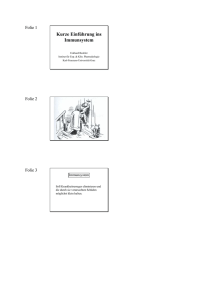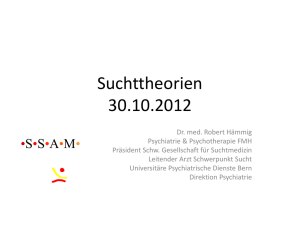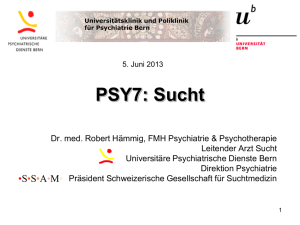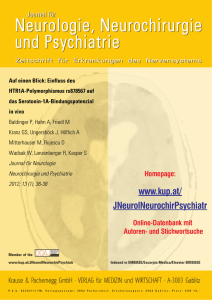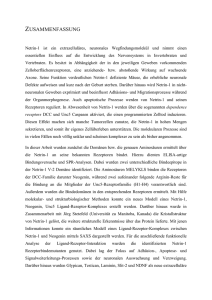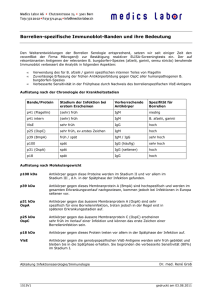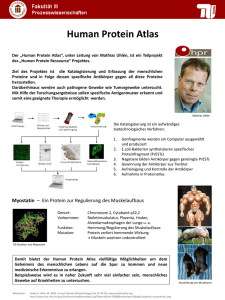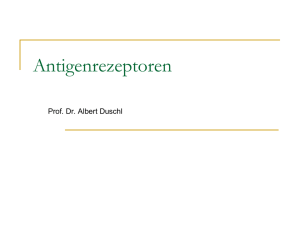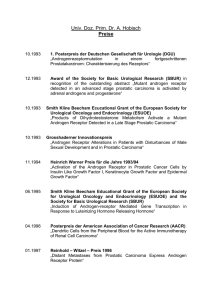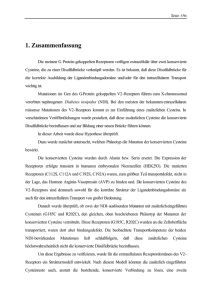und T-Zellen
Werbung
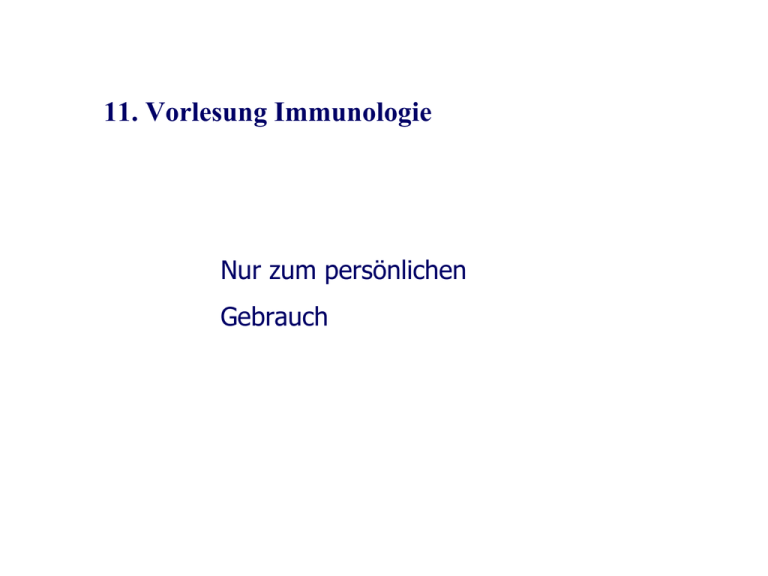
11. Vorlesung Immunologie Nur zum persönlichen Gebrauch 11. Vorlesung Immunologie Einführung - Angeborene und erworbene Immunität Zellen und Organe des Immunsystems Reifung der Lymphozyten - Apoptose Antikörper (Ak) - Entstehung der Ak-Variabilität Herstellung und Nutzung von Antikörpern T-Zell-Rezeptoren (TcR) und T-Zellen MHC (major histocompatibility complex) -Moleküle Regulationsmechanismen (Vermeidung von Reaktionen gegen "Selbst") Phylogenese der spezifischen Immunmechanismen Zusammenfassung: Immunologie I; 10. Vorlesung (1/3) 1. Spezifische Antikörper können zum Nachweis zellulär lokalisierter Antigene (z.B. in Immunfluoreszenztests) eingesetzt werden. 2. Zellulär lokalisierte Antigene können auch auf elektronenoptischer Ebene mit Hilfe von Antikörpern nachgewiesen werden, die mit elektronendichten Markern gekoppelt sind. 3. Immuntests mit spezifischen Antikörpern können nach unterschiedlicher Markierung und in unterschiedlichen Tests (z.B. Enzym-Immuntests) zum Nachweis von löslichen Antigenen eingesetzt werden. Zusammenfassung: Immunologie I; 10. Vorlesung (2/3) 4. Fest-Phasen-Enzym-Immuntests können z.B. als Zwei-SeitenBindungstests (Sandwich-Assays, wenn zwei monoklonale Antikörper zur Verfügung stehen) oder als Kompetitions-Tests (wenn nur ein monoklonaler Antikörper zur Verfügung steht bzw. wenn niedermolekulare Substanzen nachgewiesen werden sollen) durchgeführt werden. 5. Antikörper lassen sich weiterhin im Immunoblotting, einer Kombination aus Elektrophorese und Blotting, zur Identifizierung und Charakterisierung von Molekülen einsetzen. 6. Auf Grund der Reversibilität der Antigen-Antikörper-Reaktion sind Antiköper ideale Werkzeuge für die Gewinnung reiner Antigene (Immunaffinitätschromatographie). Zusammenfassung: Immunologie I; 10. Vorlesung (3/3) 7. Antikörper gegen Zelloberflächenantigene lassen sich für die Anreicherung reiner Zellpopulationen einsetzen. Ein bekanntes Verfahren beruht auf der Nutzung eines MACS (magnetic cell sorter). mark. MoAk mark. MoAk Magnet a b z.B. für KM-Transplantation & „purging“ Fluoreszenz-aktivierte Zellsortierung (FACS) L.A.Herzenberg et al. Fluorescence-activated Cell Sorting Scientific American March 1976 p108 Fluoreszenz-aktivierte Zellsortierung (FACS) L.A.Herzenberg et al. Fluorescence-activated Cell Sorting Scientific American March 1976 p108 Fluoreszenzaktivierte Zellsortierung (FACS) mark. MoAk Fluoreszenzdetektoren, Signalverarbeitung Laser + - Ablenkplatten, elektr. Feld Fluoreszenzaktivierte Zellsortierung (FACS) mark. MoAk Fluoreszenzdetektoren, Signalverarbeitung Laser + - Ablenkplatten, elektr. Feld Fluoreszenzaktivierte Zellsortierung (FACS) mark. MoAk Fluoreszenzdetektoren, Signalverarbeitung Laser + + - Ablenkplatten, elektr. Feld Fluoreszenzaktivierte Zellsortierung (FACS) mark. MoAk Fluoreszenzdetektoren, Signalverarbeitung Laser Abreißendes Tröpfchen + + - Ablenkplatten, elektr. Feld Fluoreszenzaktivierte Zellsortierung (FACS) mark. MoAk Fluoreszenzdetektoren, Signalverarbeitung Laser + + - Ablenkplatten, elektr. Feld Fluoreszenzaktivierte Zellsortierung (FACS) mark. MoAk Fluoreszenzdetektoren, Signalverarbeitung Laser + - Ablenkplatten, elektr. Feld + mark. MoAk mark. MoAk Laser Fluoreszenzdetektoren, Signalverarbeitung Abreißendes Tröpfchen Ablenkplatten, elektr. Feld a b Fig. 29.9 Cells in the sample are stained with specific fluorescent reagents to detect surface molecules and are then introduced into the vibrating flow chamber of the FACS. The cell stream passing out of the chamber is encased in a sheath of buffer fluid. The stream is illuminated by laser light and each cell is measured for size (forward light scatter) and granularity (90° light scatter), as well as for red and green fluorescence, to detect two different surface markers. The vibration in the cell stream causes it to break into droplets which are charged and may then be steered by deflection plates under computer control to collect different cell populations according to the parameters measured. The 3dimensional graphs plot size (s), number (n) and fluorescence (f) for a whole Iymphocyte population and a CD8+ population obtained by cell sorting, both stained with anti-CD8. Roitt, Brostoff & Male: Immunology. 5th ed. Mosby1998 Katalytische Antikörper ENERGY PROFILE charts the energetic demands of a hypothetical chemical reaction, from reactants to products. From its starting point the curve rises by an amount representing the reaction's activation energy. It reaches a peak corresponding to the reaction's transition state, an ephemeral complex of atoms that has no resting state. Enzymes catalyze a reaction in part by binding to the transition state and thereby stabilizing it. The activation energy of the uncatalyzed reaction (black curve) is lowered (colored curve) and the process is accelerated, often by a factor of several billion. Richard A. Lerner and Alfonso Tramontano, Catalytic Antibodies, Scientific American March 1988, page 58 HYDROLYSIS OF AN ESTER passes through an unstable transition state whose distinctive shape and charge can be mimicked by a stable molecule. The ester group and the acid product, which inherits the ester's central carbon, have a planar geometry and carry no electric charge. (R and R' represent chemical groups that do not take part in the reaction.) The transition state is tetrahedral and is polarized: a partial negative charge is concentrated at one apex. A stable analogue, in which phosphorus takes the place of the central carbon in the transition state, mimics its geometry and approximates its distribution of charge. Richard A. Lerner and Alfonso Tramontano, Catalytic Antibodies, Scientific American March 1988, page 58 CATALYTIC ANTIBODY for a reaction (an ester hydrolysis in this case) is made by coupling a transition-state analogue (a) to a carrier protein and injecting the combination into an experimental animal. Antibody-secreting spleen cells are taken from the animal and fused with cells from a myeloma, a bone-marrow cancer. The hybrid antibody-secreting cells divide indefinitely, making it possible to obtain clones of cells, each hybrid clone secreting a monoclonal antibody that has a unique binding pocket. One then selects a clone making antibody specific for the analogue. The antibody may also be capable of binding to the transition state itself (b) and thereby catalyzing the reaction. Richard A. Lerner and Alfonso Tramontano, Catalytic Antibodies, Scientific American March 1988, page 58 Richard A. Lerner and Alfonso Tramontano, Catalytic Antibodies, Scientific American March 1988, page 58 Antikörper mit zwei unterschiedlichen Spezifitäten Hybrid-Ak [F(ab‘)2] bispezifischer Einzelketten-Ak Diabody kompletter bispezifischer Ak Immunisierung Wirbeltier In-vitro-Immunisierung Serum, Eidotter B-Lymphozyten Immunglobulin Hybridome Ak-Gene Synthetische Ak-Gene Ak-Bibliotheken Polyklonale PolyklonaleAk Ak Monoklonale MonoklonaleAk Ak Rekombinante RekombinanteAk Ak Neue Methoden zur Antikörpergewinnung VL VH VH VH VL VL Ak-Gene Vektor mit VH- und VL-Genen EinzelkettenAntikörper (scAb) Phagen-Display PCR vH & vL „panning“ or scFv bi Ab Ab conjugate chimeric Ab murine Ab sc Ab humanized Ab sc Ab conjugate or fusion protein sd Ab camel Ab H chain Ab sc bi Ab hybrid Ab diabody Inaktivierung endogener Ig-Gene Knock-out-Maus keine Ak Maus-ES-Zellen XenoMaus mit humanen Ak Integration humaner Ig-Gene transgene Maus mit murinen und humanen Ak Alternativen zu Antikörpern - Peptide - andere Proteine (Affibodies - ProtA-“Abkömmlinge“, Intercaline, Avimere) - Aptamere - molekulare Imprints („Plastibodies“) Figure 3. In vitro display scaffolds a) Avimer: A-domain b) Affibody: Z-domain of protein A c) ankyrin repeat protein d) Tenth fibronectin type III domain e) Immunity protein: Im9 f) scFv Ab rot – α-Helices grün – β-Faltblätter gelb – randomisierte Reste (Bindungsstelle) orange – Disulfidbrücken (Rothe et al. FASEB J. 20 (2006) 1599-1610) Zellen des Immunsystems B-Lymphozyten (B-Zellen): synthetisieren und sezernieren Antikörper T-Lymphozyten (T-Zellen): sind Träger der zellulären Immunität, "helfen" den B- Zellen bei der Antikörpersynthese, haben regulierende Funktion B- und T-Lymphozyten sind morphologisch nicht zu unterscheiden. B- und T-Zellen können funktionell und/oder mit Hilfe von monoklonalen Antikörpern gegen Oberflächenmarker identifiziert werden. [FACS-Analyse CD-Marker, cluster of differentiation - Differenzierungsantigene] Lymphozyten mit spezifischen Rezeptoren B-Lymphozyten B-Zellen produzieren Antikörper T-Lymphozyten TH1-Zellen aktivieren Makrophagen TH2-Zellen aktivieren B-Zellen TC-Zellen TR/S-Zellen töten Virusregulieren andere infizierte Zellen Immunzellen erkennen fremde Antigene; Rezeptoren sind durch somatisch rekombinierte Gene kodiert Fig. A.24 The distribution of lymphocyte subpopulations in human peripheral blood. Fig. 3.11 The T-cell receptor resembles a membrane-bound Fab fragment. The Fab fragment of an antibody molecule is a disulfide-linked heterodimer, each chain of which contains one immunoglobulin C domain and one V domain; the juxtaposition of the V domains forms the antigen-binding site. The T-cell receptor is also a disulfidelinked heterodimer, with each chain containing an immunoglobulin C-like domain and an immunoglobulin V-like domain. As in the Fab fragment, the juxtaposition of the V domains forms the site for antigen recognition. T-Zell-Rezeptoren (TCR) ähneln im Aufbau den Immunglobulinen (variable und konstante Regionen, Antigen-Bindungs-Ort). T-Zell-Rezeptoren sind immer zellulär lokalisiert. Die funktionelle Einheit an der Oberfläche von T-Zellen ist der TCR-CD3-Komplex. Fig. 3.12 Structure of the T-cell receptor. The T-cell receptor heterodimer is composed of two transmembrane glycoprotein chains, α and β. The extracellular portion of each chain consists of two domains, resembling immunoglobulin V and C domains, respectively. Both chains have carbohydrate side chains attached to each domain. A short segment, analogous to an immunoglobulin hinge region, connects the immunoglobulin-like domains to the membrane and contains the cysteine residue that forms the interchain disulfide bond. The transmembrane helices of both chains are unusual in containing positively charged (basic) residues within the hydrophobic transmembrane segment. The α chain carries two such residues; the β chain has one. Fig. 6.9 The T-cell receptor complex is made up of antigenrecognition proteins and invariant signaling proteins. In the functional receptor complex, α:β heterodimers are associated with a complex of four other signaling chains (two ε, one δ, one γ) collectively called CD3, which are required for the cell­surface expression of the antigen­binding chains and for signaling. The cellsurface receptor complex is also associated with a homodimer of ζ (zeta) chains, which signal to the interior of the cell upon antigen binding. Der überwiegende Teil der T-ZellRezeptoren ist aus α- und β-Ketten aufgebaut. Die Kristallstruktur eines α:β T-ZellRezeptors ähnelt der der Immunoglobuline. Ein kleiner Teil der T-Zell-Rezeptoren ist aus γ- und δ-Ketten aufgebaut. Fig. 3.13 The crystal structure of an α:β T-cell receptor resolved at 2.5 A. In panels a and b the α chain is shown in pink and the β chain in blue. Disulfide bonds are shown in green. In panel a, the T-cell receptor is viewed from the side as it would sit on a cell surface, with the CDR loops that form the antigen-binding site (labeled 1, 2, and 3) arrayed across its relatively flat top. In panel b, the Cα and Cβ domains are shown. The Cα domain does not fold into a typical immunoglobulin-like domain; the face of the domain away from the Cβ domain is mainly composed of irregular strands of polypeptide rather than β sheet. In panel c, the T-cell receptor is shown aligned with the antigen-binding sites from three different antibodies. This view is looking down into the binding site. The Vα domain of the T-cell receptor is aligned with the VL domains of the antigen-binding sites of the antibodies, and the Vβ domain is aligned with the VH domains. CDRs 1, 2, and 3 of the TCR are shown in red and the HV4 loop in orange. The HV4 loops of the TCR (orange) have no hypervariable counterparts in immunoglobulins. Die Variabilität der unterschiedlichen TZell-Rezeptor-Spezifitäten im V-Teil entsteht, wie bei den Immunglobulinen, durch somatische V(D)J-Rekombination. Es gibt bei T-Zell-Rezeptoren keine somatische Hypermutation. Fig. 4.12 T-cell receptor α- and β-chain gene rearrangement and expression. Fig. 4.25 Changes in immunoglobulin and T-cell receptor genes that occur during B-cell and T-cell development and differentiation. * * Fig. 4.13 The numbers of human T-cell receptor gene segments and the sources of T-cell receptor diversity compared with those of immunoglobulins. Fig. 8.3 The numbers refer to the chromosomal location of the genes for the various peptides in man and mouse. Note that all of the loci are completely separate, with the single exception of the T-cell receptor (TCR) δ chain which lies within the TCR α loci. Roitt, Brostoff, Male: Immunology 5th ed. Mosby 1998 Fig. 4.15 The organization of the T-cell receptor γ- and δ­ chain loci in humans. Neben T-Zellen mit α:β T-Zell-Rezeptoren gibt es T-Zellen mit γ:δ TCR. Sie stellen eine Minderheit dar. Ihre Funktion ist nicht eindeutig geklärt. Auch hier entsteht die Variablität durch V(D)JRekombination. Verglichen mit α:β T-ZellRezeptoren ist die Variablität der γ:δ TCR geringer, das Spektrum der erkannten Antigene ist offenbar limitiert.
